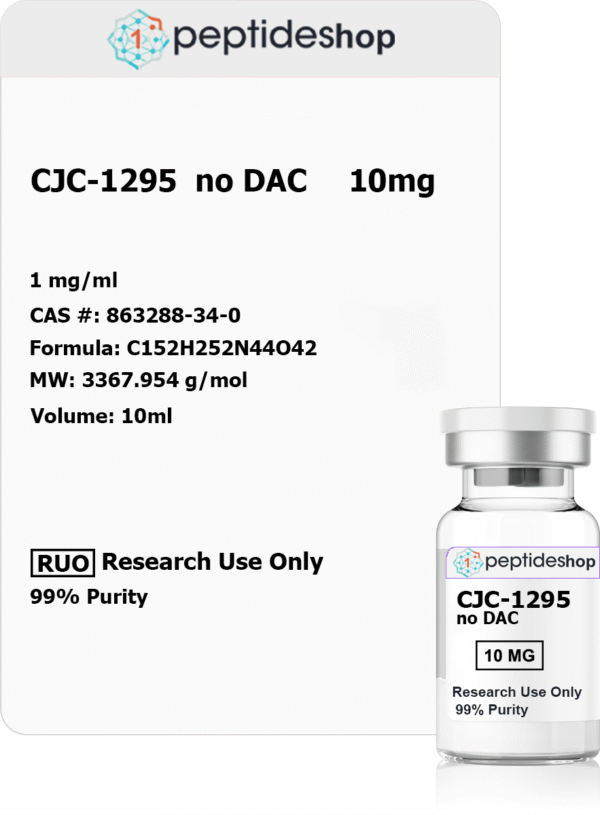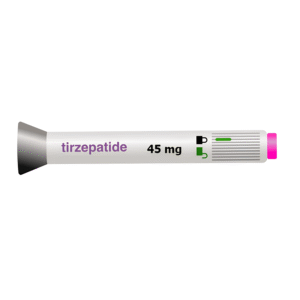CJC-1295 no DAC (10mg)
Original price was: $70.00.$46.00Current price is: $46.00.
CJC-1295 No DAC is a truncated peptide analogue of growth hormone releasing hormone (GHRH). First developed in the 1980s, research studies with modGRF have shown it to improve muscle repair and growth, accelerate wound healing, strengthen bones, increase fat burning, and improve metabolism. It may also have beneficial effects on blood sugar regulation and the immune system.
Contents of the Package
- 1 x sterile 10ml multi-dose vial
- Active ingredient: CJC-1295 (without DAC) at 1mg/ml
- Diluted in bacteriostatic saline
- Clear, sterile injectable fluid
- Packaged in USP-grade, tamper-evident vial
- Intended for subcutaneous use only
About CJC-1295 no DAC
CJC-1295 (without DAC) is a synthetic Growth Hormone Releasing Hormone (GHRH 1-29) analog, designed to stimulate the anterior pituitary to release endogenous growth hormone (GH) in natural pulses. It is structurally similar to sermorelin, but with greater stability and potency.
Unlike CJC-1295 with DAC, this formulation does not include Drug Affinity Complex (DAC), meaning it has a much shorter half-life and requires more frequent administration to mimic physiological GH pulsatility. This makes it an ideal option for those seeking precise control over GH release timing, especially when combined with a GHRP like Ipamorelin.
Mechanism of Action
CJC-1295 (without DAC) mimics endogenous GHRH, binding to receptors on the anterior pituitary and stimulating growth hormone secretion. Its short-acting profile produces a natural-like GH pulse, which promotes downstream production of IGF-1 from the liver.
Key effects include:
- Stimulation of GH release without suppressing natural feedback loops
- No impact on cortisol or prolactin levels
- Enhances lipolysis, protein synthesis, and recovery
- Supports collagen formation, joint repair, and improved sleep quality
When paired with GHRPs (like Ipamorelin), the combined effect is a synergistic GH surge, enhancing both pulse frequency and amplitude.
Adverse Reactions
CJC-1295 (without DAC) is generally well tolerated, especially at physiological doses.
Possible side effects may include:
- Mild fatigue or drowsiness after injection
- Temporary flushing or warmth
- Increased hunger (when combined with GHRPs)
- Mild headache or injection site irritation
- Rare: tingling or lightheadedness
Most side effects are short-lived and dose-dependent.
Benefits
Potential Benefits:
- Increased lean muscle mass and fat metabolism
- Improved sleep, recovery, and energy
- Enhanced IGF-1 levels for anti-aging and regeneration
- Joint, skin, and connective tissue support
- Natural GH stimulation without shutting down endogenous production
Side Effects
⚠️ Possible Side Effects:
- Injection site discomfort
- Temporary fatigue or mild headache
- Increased appetite (more likely with GHRP pairing)
- Water retention or bloating (at higher doses)
These effects are generally mild and well controlled with proper dosing.
Contraindications & Precautions
- Avoid in individuals with active cancers or uncontrolled tumor growth
- Caution in those with pituitary adenomas or GH-sensitive malignancies
- Not recommended in patients with untreated thyroid, adrenal, or glucose metabolism disorders
- Monitor IGF-1 and fasting glucose during prolonged use
Drug Interactions
CJC-1295 (without DAC) is frequently paired with:
- GHRPs (e.g., Ipamorelin, GHRP-2, GHRP-6)
- Metabolic peptides (e.g., Semaglutide, L-Carnitine)
- Recovery enhancers (e.g., BPC-157, TB-500)
No direct drug-drug interactions are known, though monitoring is advised when used alongside hormone-modulating therapies.
Pregnancy & Breastfeeding
This compound is not recommended during pregnancy or lactation. While GH modulation plays a physiological role during pregnancy, the effects of exogenous GHRH analogs have not been evaluated in pregnant or nursing individuals.
Children
CJC-1295 (without DAC) is not approved for pediatric use. While GH modulation can be therapeutic in GH-deficient children, use should be strictly supervised by a pediatric endocrinologist.
FDA approval
CJC-1295 (without DAC) is not approved by the FDA as a pharmaceutical drug. It is classified as an investigational compound, commonly used in compounding, functional medicine, and regenerative therapy protocols.
References
- Walker RF, et al. (2006). “Comparative pharmacodynamics of GHRH analogs.” Growth Hormone & IGF Research.
- Teichman SL, et al. (2006). “Pharmacokinetics of long- and short-acting CJC-1295 formulations.” J Clin Endocrinol Metab.
- Garcia JM, et al. (2007). “Clinical applications of GHRH analogs in aging and muscle loss.” Expert Opinion on Investigational Drugs.
- Meinhardt U, et al. (2010). “Pulsatile vs continuous GH stimulation and physiologic outcomes.” Hormone Research in Paediatrics.
- Smith RG, et al. (2005). “The evolving role of GH secretagogues.” Endocrine Reviews.





